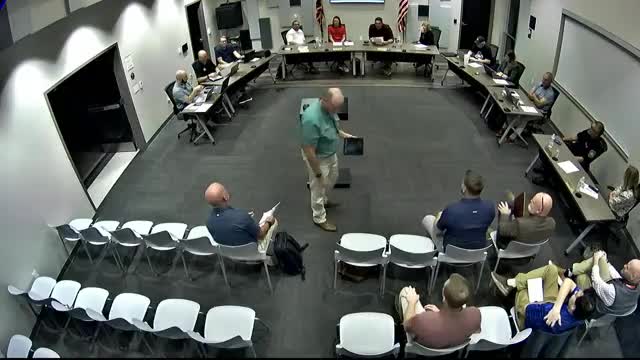Council reviews draft architectural design standards for commercial and multifamily developments; staff recommends 40% remodel threshold
October 02, 2025 | Plain City Council, Plain City, Madison County, Ohio
This article was created by AI summarizing key points discussed. AI makes mistakes, so for full details and context, please refer to the video of the full meeting. Please report any errors so we can fix them. Report an error »

Plain City staff presented a draft ordinance-level architectural design standard for commercial, industrial, institutional and multifamily development and discussed how the city would treat existing buildings that are renovated. The council generally supported a 40% remodel threshold for applying the new standards and directed staff to carry the draft to Planning & Zoning.
A staff speaker opened the topic by saying, “So tonight, we're talking about architectural design standards,” then explained the draft targets higher-quality materials (brick, stone, stucco, fiber cement, textured concrete, metal panels) and discourages large expanses of low-durability materials such as full vinyl siding except as small accents. Staff said the standards were intended to raise corridor appearance and durability and to be required as part of a major site-plan submittal.
Staff asked the council to weigh whether the design standard should force upgrades on existing buildings and — if so — when. The draft recommends that an exterior renovation replacing more than a specified percentage of the facade (staff proposed 40% in the session) would require the upgraded materials under the new standard. Council members asked whether natural disasters or insurance-driven rebuilds would be exceptions; staff said waivers would be considered through the Planning & Zoning Commission process.
Council members asked about practical effects on existing businesses (the meeting cited a car-wash example) and about compatibility with projects already approved under other PUD or Uptown-specific rules. Staff clarified Uptown District properties would remain subject to their own standards and that the proposed rules would act as a default standard for other areas. Staff also said the city would allow limited exceptions if applicants demonstrated equal or greater durability than a required material.
On timing, staff said the draft will go before the Planning & Zoning Commission on the fifteenth and that the council’s goal is to have the standard adopted early next year (staff noted a February 1 implementation goal). Several council members signaled informal support for a 40% remodel threshold during the work session; one councilmember said, “40 is pretty common.”
There was no ordinance vote at the work session. Staff will take the draft to Planning & Zoning for public hearing and then return to council with recommended language; code adoption requires the normal P&Z review, public hearing and council vote. Staff also said early commercial projects tied to imminent road and utility improvements (e.g., a new gas station pad) may appear in site-plan reviews next year and would be subject to the adopted standard once the code is in effect.
Ending: Council members asked staff to add clarifying language about when renovations trigger compliance, permit waivers for disaster-driven rebuilds to be considered by P&Z, and the relationship between the new rules and existing PUD/uptown standards. The work session did not adopt final language; Planning & Zoning review is the next step.
A staff speaker opened the topic by saying, “So tonight, we're talking about architectural design standards,” then explained the draft targets higher-quality materials (brick, stone, stucco, fiber cement, textured concrete, metal panels) and discourages large expanses of low-durability materials such as full vinyl siding except as small accents. Staff said the standards were intended to raise corridor appearance and durability and to be required as part of a major site-plan submittal.
Staff asked the council to weigh whether the design standard should force upgrades on existing buildings and — if so — when. The draft recommends that an exterior renovation replacing more than a specified percentage of the facade (staff proposed 40% in the session) would require the upgraded materials under the new standard. Council members asked whether natural disasters or insurance-driven rebuilds would be exceptions; staff said waivers would be considered through the Planning & Zoning Commission process.
Council members asked about practical effects on existing businesses (the meeting cited a car-wash example) and about compatibility with projects already approved under other PUD or Uptown-specific rules. Staff clarified Uptown District properties would remain subject to their own standards and that the proposed rules would act as a default standard for other areas. Staff also said the city would allow limited exceptions if applicants demonstrated equal or greater durability than a required material.
On timing, staff said the draft will go before the Planning & Zoning Commission on the fifteenth and that the council’s goal is to have the standard adopted early next year (staff noted a February 1 implementation goal). Several council members signaled informal support for a 40% remodel threshold during the work session; one councilmember said, “40 is pretty common.”
There was no ordinance vote at the work session. Staff will take the draft to Planning & Zoning for public hearing and then return to council with recommended language; code adoption requires the normal P&Z review, public hearing and council vote. Staff also said early commercial projects tied to imminent road and utility improvements (e.g., a new gas station pad) may appear in site-plan reviews next year and would be subject to the adopted standard once the code is in effect.
Ending: Council members asked staff to add clarifying language about when renovations trigger compliance, permit waivers for disaster-driven rebuilds to be considered by P&Z, and the relationship between the new rules and existing PUD/uptown standards. The work session did not adopt final language; Planning & Zoning review is the next step.
View full meeting
This article is based on a recent meeting—watch the full video and explore the complete transcript for deeper insights into the discussion.
View full meeting
